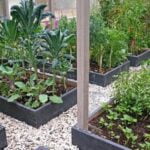Are you interested in growing your own fresh vegetables at home, regardless of the season or outdoor space availability? If so, then indoor vegetable gardens may be the perfect solution for you.
With the help of advanced technology such as LED grow lights, it is now possible to cultivate a wide variety of vegetables right in the comfort of your own home. In this article, we will explore everything you need to know about using LED grow lights for indoor vegetable gardens.
Indoor vegetable gardens offer numerous advantages, including access to fresh produce year-round and the ability to control the growing conditions for optimal plant growth. One key component that has revolutionized indoor gardening is the use of LED grow lights.
These specialized lights provide the necessary spectrum for photosynthesis and can mimic natural sunlight, allowing plants to thrive in an indoor environment. Whether you are new to indoor gardening or looking to upgrade your current setup, understanding the benefits and types of LED grow lights is essential for success.
When it comes to choosing LED grow lights for your indoor vegetable garden, there are several factors to consider. From light intensity and spectrum to energy efficiency and cost-effectiveness, selecting the right grow lights can make a significant impact on your plants’ growth and overall harvest.
Additionally, setting up and maintaining these lights properly is crucial for maximizing their efficiency and ensuring long-term success with your indoor vegetable garden. In this article, we will delve into all aspects of using LED grow lights for indoor vegetable gardens, providing valuable insights and tips for a successful gardening experience.
Benefits of Using Led Grow Lights for Indoor Vegetable Gardens
Indoor vegetable gardens offer a convenient and sustainable way to grow fresh produce year-round, regardless of the outdoor climate. With the advancement in technology, using LED grow lights for indoor vegetable gardens has become increasingly popular due to its numerous benefits.
One of the primary benefits of using LED grow lights for indoor vegetable gardens is energy efficiency. Unlike traditional lighting sources, LED lights consume significantly less energy while still providing the necessary light spectrum for plant growth. This not only reduces electricity costs but also makes it more environmentally friendly.
Another benefit of using LED grow lights is their longevity. LED bulbs have a much longer lifespan compared to other types of lighting, reducing the frequency of replacements and saving money in the long run. Additionally, LED grow lights produce less heat than traditional options, creating a more favorable environment for plant growth and reducing the risk of damage from overheating.
In addition to energy efficiency and longevity, LED grow lights are also customizable, allowing for precise control over the light spectrum and intensity. This means that indoor gardeners can tailor the lighting to meet the specific needs of different vegetables at various stages of growth, ultimately leading to healthier and more abundant harvests. Overall, the use of LED grow lights for indoor vegetable gardens offers significant advantages in terms of cost savings, environmental impact, and improved plant growth.
Understanding the Different Types of Led Grow Lights
When it comes to choosing the right LED grow lights for your indoor vegetable garden, it’s important to understand the different types available in the market. LED grow lights come in various shapes, sizes, and spectrums, each designed to cater to specific plant needs. The three main types of LED grow lights are traditional LED, COB (Chip on Board) LED, and quantum board LED.
Traditional LEDs are the most common type of LED grow lights and consist of individual bulbs or diodes. They are known for their energy efficiency and ability to produce targeted light wavelengths that are beneficial for plant growth. COB LEDs, on the other hand, are made up of multiple diodes packaged together as a single module. They are preferred for their high light intensity and better canopy penetration compared to traditional LEDs.
Quantum board LEDs have gained popularity in recent years due to their high efficiency and uniform light distribution. These LED grow lights consist of numerous mid-power LEDs mounted on a flat board, providing an even distribution of light across the entire growing area. Understanding the differences between these types of LED grow lights will help you make an informed decision when setting up your indoor vegetable garden.
| Types of LED Grow Lights | Main Features |
|---|---|
| Traditional LED | Individual bulbs or diodes; energy efficient; targeted light wavelengths |
| COB (Chip on Board) LED | Multiple diodes packaged together; high light intensity; better canopy penetration |
| Quantum Board LED | Mid-power LEDs mounted on a flat board; high efficiency; uniform light distribution |
Factors to Consider When Choosing Led Grow Lights for Indoor Vegetable Gardens
When considering the right led grow lights for your indoor vegetable garden, there are several important factors to keep in mind. One crucial factor to consider is the light intensity provided by the grow lights.
Different vegetables require different levels of light intensity, so it’s essential to choose a grow light that can meet the specific needs of the vegetables you plan to grow. Leafy greens, for example, need lower light intensity compared to fruiting vegetables such as tomatoes or peppers.
Another important consideration is the color spectrum of the led grow lights. Different stages of plant growth require different light spectrums, so ensure that the grow lights you choose provide a full spectrum that includes blue and red light wavelengths. Blue light is essential for vegetative growth, while red light promotes flowering and fruiting.
The size of your indoor vegetable garden and the space available for installing led grow lights is also an important factor to consider. If you have a small space, then compact led grow lights might be more suitable. On the other hand, larger spaces may require multiple LED panels or larger fixtures to ensure even coverage throughout the garden.
| Factors to Consider | Considerations |
|---|---|
| Light Intensity | Different vegetables require different levels of light intensity |
| Color Spectrum | Ensure grow lights provide a full spectrum with blue and red light wavelengths |
| Space Available | Choose compact LED lights for small spaces or multiple panels/fixtures for larger areas |
By carefully considering these factors when choosing led grow lights for your indoor vegetable garden, you can ensure that your plants receive the right amount and type of light they need for healthy growth and bountiful harvests.
Setting Up Led Grow Lights in Your Indoor Vegetable Garden
When setting up led grow lights for your indoor vegetable garden, it’s important to consider the layout and size of your garden space. Here are some steps to help you set up your led grow lights effectively:
1. Determine the layout of your garden space: Before installing the led grow lights, assess the layout of your indoor vegetable garden. Consider where each type of vegetable will be placed and how much light they will need.
2. Choose the right type of led grow lights: There are different types of led grow lights available, including full spectrum, red/blue spectrum, and white spectrum lights. Full spectrum lights are ideal for promoting overall plant growth, while red/blue spectrum lights are best for encouraging fruiting and flowering. White spectrum lights provide a balanced combination of both.
3. Install the led grow lights at the correct height: The distance between the plants and the led grow lights is crucial for their effectiveness. Hang the lights at an appropriate height according to the specific needs of your vegetables. Typically, leafy greens require 12-18 inches, while fruiting plants need 24-36 inches from the light source.
By following these steps, you can ensure that your indoor vegetable garden receives adequate light from led grow lights to support healthy plant growth and maximize yield.
Best Vegetables to Grow Using Led Grow Lights
Growing vegetables indoors using LED grow lights can be a rewarding and efficient way to ensure a year-round supply of fresh produce. When choosing which vegetables to grow in your indoor garden, it’s important to consider the space available, the amount of light needed, and the time it takes for each vegetable to mature. Here are some of the best vegetables to grow using LED grow lights for your indoor vegetable garden:
- Leafy Greens: Vegetables like lettuce, spinach, kale, and Swiss chard thrive in indoor environments with consistent lighting. These vegetables are relatively low maintenance and can be harvested multiple times.
- Herbs: Basil, cilantro, parsley, and other herbs are excellent choices for indoor gardens as they don’t require a lot of space and can be easily grown in pots or small containers.
- Tomatoes: With the right conditions and adequate light from LED grow lights, tomatoes can flourish indoors. Dwarf or cherry tomato varieties are particularly well-suited for indoor cultivation.
- Peppers: Both sweet peppers and hot peppers can be successfully grown indoors with the help of LED grow lights. Compact varieties work best for limited spaces.
It’s important to note that while many vegetables can thrive under LED grow lights, some may require more intense lighting or specific light spectrum adjustments at different stages of growth. Understanding the light requirements of each vegetable is crucial for successful indoor gardening.
In addition to these options, there are plenty of other vegetables that can be grown using LED grow lights in your indoor garden. Experimenting with different varieties and observing their growth under artificial lighting can help you determine which vegetables are best suited for your specific setup.
Tips for Maximizing the Efficiency of Led Grow Lights
Proper Placement of Lights
When setting up your led grow lights for indoor vegetable gardens, it’s important to ensure that the lights are positioned at the correct distance from the plants. Different types of vegetables may have different light intensity requirements, so it’s essential to research the specific needs of the vegetables you are growing.
For example, leafy greens may require less intense light compared to fruiting vegetables. By placing the lights at the optimal distance from the plants, you can ensure that they receive the right amount of light for healthy growth.
Use a Timer
To maximize the efficiency of your led grow lights and to simulate natural sunlight, consider installing a timer for your lights. This will allow you to set specific schedules for when the lights should be on and off. For most vegetable plants, they will need about 12-16 hours of light per day. Using a timer not only ensures that your plants get adequate light but also helps in conserving energy by not keeping the lights on constantly.
Invest in Quality Reflective Material
To make the most out of your led grow lights, consider using reflective material around your indoor garden area. This will help to bounce light back onto the plants, maximizing its efficiency and reaching more areas of your garden. You can use materials such as Mylar or white plastic sheeting to create a reflective surface around your plants.
By following these tips and incorporating them into your indoor vegetable garden setup, you can truly maximize the efficiency of your led grow lights for optimal plant growth and harvest.
Maintenance and Care for Led Grow Lights for Indoor Vegetable Gardens
Regular Cleaning
One of the most important aspects of maintaining led grow lights for indoor vegetable gardens is regular cleaning. Dust and dirt can build up on the lights, reducing their efficiency. Make sure to clean the lights at least once a month using a soft cloth or brush to gently remove any debris.
Check for Heat Buildup
Led grow lights can generate heat during operation, and excessive heat can reduce their lifespan. It’s important to check for any signs of heat buildup on the lights and ensure that they are adequately ventilated. If the lights feel excessively hot, consider adding additional cooling or reducing the operating time to prevent damage.
Inspect for Damage
Regularly inspecting your led grow lights is crucial for ensuring their longevity and performance. Check for any signs of damage such as loose connections, frayed wires, or malfunctioning components. Addressing these issues promptly can prevent further damage and extend the lifespan of your lights.
By following these maintenance and care tips, you can ensure that your led grow lights for indoor vegetable gardens remain in optimal condition, providing the necessary lighting for your plants to thrive. Regular cleaning, monitoring heat buildup, and inspecting for damage are essential practices that will help maximize the efficiency and lifespan of your led grow lights.
Conclusion
In conclusion, the use of Led grow lights for indoor vegetable gardens has revolutionized the way we can grow our favorite vegetables in the comfort of our own homes. The benefits of using these innovative lights are evident, from their energy efficiency to their ability to provide plants with the specific light spectrum they need for optimal growth. As technology continues to advance, the future of indoor vegetable gardens with Led grow lights looks promising and exciting.
With a better understanding of the different types of Led grow lights and factors to consider when choosing them, setting up and maintaining an indoor vegetable garden has become more accessible than ever. The ability to grow a variety of vegetables year-round is no longer limited by seasonal changes or outdoor growing conditions. This not only provides convenience but also opens up opportunities for those living in urban areas or regions with limited space for traditional gardening.
As more people recognize the potential of using Led grow lights for indoor vegetable gardens, it’s essential to continue sharing tips and best practices for maximizing their efficiency. From selecting the right vegetables to establishing a proper maintenance routine, there are many ways to ensure that your indoor garden thrives under the glow of these innovative lights.
With ongoing research and development in horticulture lighting, we can expect even more tailored solutions for indoor gardening in the near future. The possibilities are endless, and the future holds great promise for anyone looking to cultivate fresh, home-grown produce with Led grow lights for their indoor vegetable gardens.
Frequently Asked Questions
What LED Lights Are Best for Growing Vegetables Indoors?
The best LED lights for growing vegetables indoors are those with a full spectrum that includes both red and blue light. These wavelengths are essential for the different stages of plant growth, from germination to fruiting.
Can Vegetables Be Grown Indoors With Grow Lights?
Yes, vegetables can definitely be grown indoors with the help of grow lights. In fact, grow lights are essential for indoor vegetable gardening as they provide the necessary light energy for photosynthesis, allowing plants to grow and produce fruits or vegetables.
How Many Hours of Light Do Indoor Vegetables Need?
Indoor vegetables usually need around 14-16 hours of light per day in order to thrive. This is because most vegetable crops require long daylight hours to grow and develop properly. It’s important to provide consistent and adequate lighting to mimic natural sunlight for successful indoor vegetable gardening.

If you’re looking to get into vegetable gardening, or are just looking for some tips on how to make your current garden better, then you’ve come to the right place! My name is Ethel and I have been gardening for years. In this blog, I’m going to share with you some of my best tips on how to create a successful vegetable garden.





